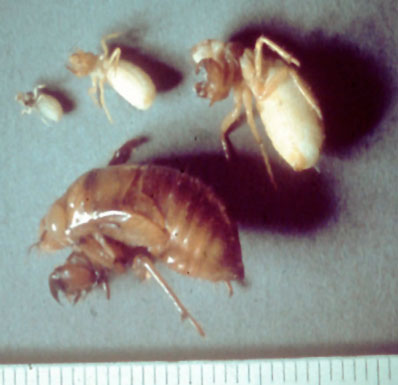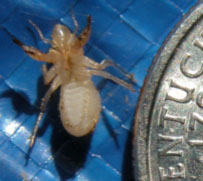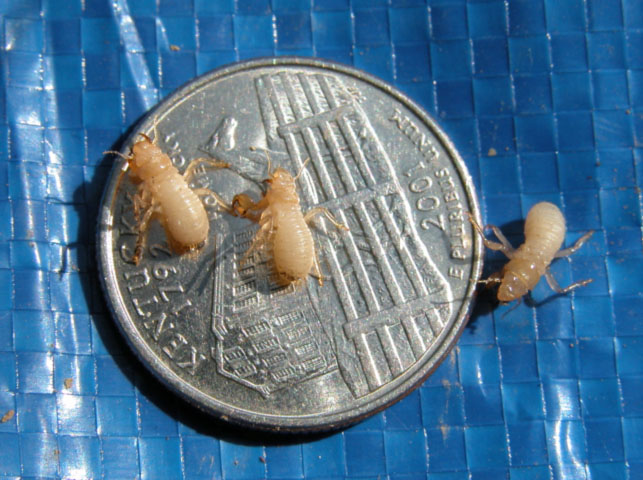The Simon Lab Nymph Tracking Project
If you did not have a periodical cicada emergence this year, you may be feeling left out! Fret no more! Here is a citizen scientist project for people who have had periodical cicadas on their property in past 13 or 17 years, e.g., 17-year Brood I in 2012 in the Shenandoah Valley of Virginia, Brood XIV in 2008 throughout the eastern US from Tennessee and North Carolina northward, Brood XIII in 2007 in northern Illinois, Brood X in 2004 throughout the eastern US from Tennessee and North Carolina northward, Brood IX in 2003 in West Virginia, Virginia, and North Carolina, Brood VIII in 2002 western Pennsylvania, Brood VII in 2001 in upstate NY, Brood VI in 2000 in North and South Carolina, Brood V in 1999 in West Virginia and Eastern Ohio, Brood IV in 1998 along the eastern edge of the Great Plains and Brood III in Eastern Iowa in 1997. Or 13-year Brood XIX in the Mississippi Valley in 2011 and across the SE US, Brood XXII in Louisiana in 2001, and Brood XXIII in the Mississippi Valley in 2002. See the periodical cicada brood maps
Help us find periodical cicada nymphs underground!
What these nymphs will tell us. Nymphs grow at different rates underground. We wish to compare growth rates of nymphs from different latitudes and habitats so that we can understand how their life cycle is regulated and how 13-year cicadas differ from 17-year cicadas. (For studies of this kind, see White and Lloyd, 1975. Growth rates of 17- and 13-year periodical cicadas, American Midland Naturalist 94: 127-143.)
Magicicada Biology Class Exercise. Are you teaching a science class and looking for a class project? We have prepared a field exercise that you can use in your classes.
 Why your nymph specimens are important to us. The nymph specimens you send us will be used to document the life cycle stage (one of five instars) and growth patterns (weight at a given age). DNA and RNA will be extracted from some of the specimens to search for genes related to life cycle control.
Why your nymph specimens are important to us. The nymph specimens you send us will be used to document the life cycle stage (one of five instars) and growth patterns (weight at a given age). DNA and RNA will be extracted from some of the specimens to search for genes related to life cycle control.
Periodical cicadas pass through five nymphal instars. Instars 2-5 are pictured in this photo by JoAnn White. The ruler on the bottom is marked in millimeters. |
How to dig for periodical cicada nymphs:
- Look for egg scars on trees (these can be seen as rows of scars on the underside of branches). The scars become less distinct as the trees age and the branches grow larger. Scars are most common along forest edges.
- Dig in the ground under the scars in an area likely to have roots. Dig to a shovel’s depth. Turn over piles of dirt until nymphs are found. If no nymphs are seen, move on to a new place. If nymphs are found, shovel the dirt onto a tarp or plastic trash bag and search through the pile carefully. Wear cotton gardening gloves to avoid poison ivy. Cicadas are often found inside small clods of dirt sitting inside of their mud cells.
- If nymphs are found, keep them in a bit of soil to avoid drying and then when you get to a freezer clean off the dirt, double bag the nymphs in a Ziplock and freeze immediately. Send an email message to Chris Simon. We will send you a vial of preservative and a prepaid self-addressed envelope. When you send back the nymphs, include contact details. We will identify the nymphs to instar and report back. Nymphs grow at different rates underground and we are trying to understand growth differences between 13- and 17-year cicadas.
If you have large numbers of nymphs and wish to participate in on-going research, please let us know!
 Photos right and below show five-year old third instar nymphs from Tomlinson Run S.P. West Virginia. The darker colored front legs, adapted for digging, distinguish these soil dwellers from other insects. The straw-like sucking mouthparts can be seen in the photo to the right. Photos by C. Simon
Photos right and below show five-year old third instar nymphs from Tomlinson Run S.P. West Virginia. The darker colored front legs, adapted for digging, distinguish these soil dwellers from other insects. The straw-like sucking mouthparts can be seen in the photo to the right. Photos by C. Simon
|

|